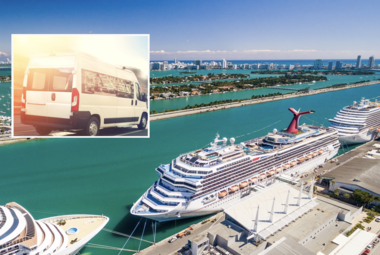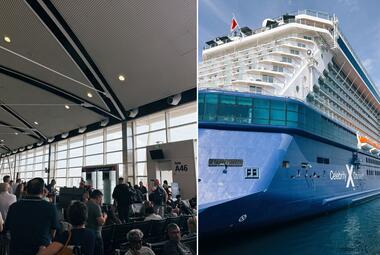While Bahamas and Caribbean cruises are popular year-round, the Alaska cruise season is short-lived. Sailings typically begin in late April and go through early October. The peak season, however, falls between June and August.
If you are planning an Alaska cruise, you might be wondering if you need a passport. It is crucial that you understand whether you need one or not prior to booking your cruise, as no refunds are provided for failure to provide proper documentation.
As a standard rule, if you are a United States citizen, you do not need a passport on a closed-loop sailing (we will get more into that later). Yes, that is right: you do not need a passport for every cruise.
What, though, if your cruise begins in Seattle, Washington and ends in Seward, Alaska? Or perhaps you found a great deal on a cruise that departs from Vancouver, Canada! In this instances, you are going to want to have a valid passport handy.
Here is everything you need to know about cruising to Alaska with and without a valid passport.
What is a closed-loop cruise?

A closed-loop cruise is one that begins and ends in the same port. Most cruise itineraries are closed-loop simply because the logistics for passengers are easier to arrange.
By beginning and ending in the same port, roundtrip flights can be booked, and anyone who drives to the port will have their vehicle available to them when the ship returns. Driving to Seattle would not be of much use if your cruise ended elsewhere, would it?
The issue, however, with closed-loop cruises is that because the ship must return to the original port, it cannot travel to as many different ports. For that reason, most cruise lines offer open-jaw sailings, especially in Europe and Alaska, which allow guests to experience different (and often more unique) ports of call.
Why you should always cruise with a passport
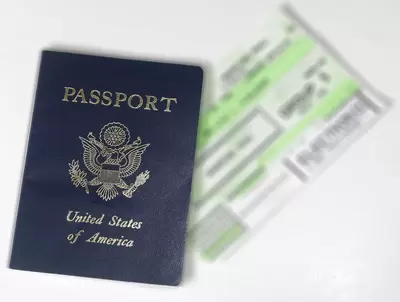
Before we get into whether or not you need a passport for you Alaskan cruise, let's talk about why cruising with a passport is more important than ever, even if you do not technically need one.
Let's say there is a mechanical emergency that requires cruise passengers disembark in a foreign port, rather than the same U.S. port that you began your cruise in. In this case, you would be stuck dealing with the local embassy to get an emergency passport, while those with passports can easily make arrangements to get home.
Cruising with a passport brings peace of mind in that in the event of an unlikely and unfortunate emergency, you can get home easily and safely. What if you book a third-party excursion in Canada that gets delayed due to traffic and you miss the ship? In this case, you will surely regret not having a passport.
In Alaska, you might not think too much about this. Alaska is part of the United States, right? Well, due to the state's proximity to Canada, you may find yourself stranded in a different country if something does go astray!
If you go ahead and make sure that you have a valid passport, you will not have to worry about future vacations, either! What if you found an incredible flight deal to a foreign country that you could not pass up? Having a passport ensures that you never miss out on these kids of opportunities!
Read more: Where can you cruise without a passport?
Do you need a passport for an Alaskan cruise?
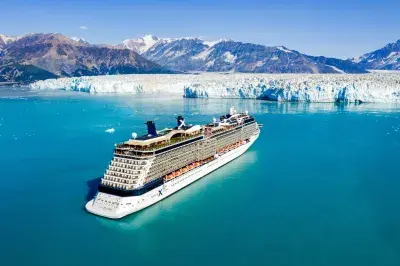
The answer depends on your itinerary, as not all Alaskan cruises require passengers to have a passport. Again, as a good rule of thumb, you should always cruise with a passport, even if it is not technically required.
If you are sailing on a closed-loop Alaska cruise that departs from somewhere within the United States (i.e., Seattle, San Francisco, etc.), you can cruise with a valid driver's license and birth certificate. Even if you dock somewhere in Canada for the day, this is an acceptable form of identification.
This is an example of a closed-loop Alaska cruise onboard Celebrity Solstice, as the 7-night itinerary cruise both begins and ends in Seattle, Washington. It is a great cruise that visits some of Alaska's highlights, despite having to return to the same departure port.
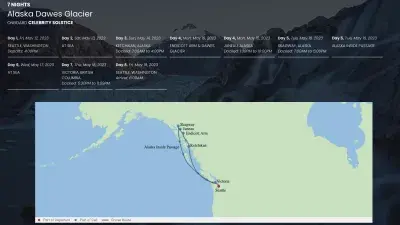
Note that it does include a stop in Victoria, British Columbia. This is so that the ship does not violate the Passenger Vessel Services Act. Although the ship is making a stop in Canada, you are still not required to have a passport for this itinerary.
You will need a valid passport if your cruise is begins or ends in Canada, is an open-jaw sailing, or you are an international cruiser (i.e., not a United States citizen). You will want to ensure that your passport's expiration date is six months later than the cruise. Otherwise, it will not be accepted. If, for example, your cruise departs on June 17, 2023, your passport will need to be valid through at least December 17, 2023.
Below is an example of an itinerary onboard Princess Cruises' Sapphire Princess where you would need a passport. It is both an open-jaw sailing and one that ends in Canada, as the cruise departs from Anchorage (Whittier), Alaska and ends in Vancouver, Canada.
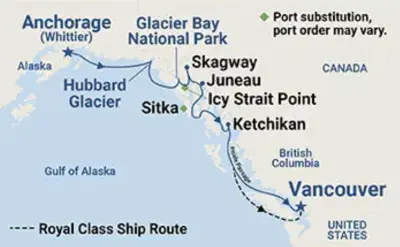
If you are looking for a cheap cruise to Alaska, you may find that open-jaw sailings are cheaper than closed-loop ones. This is because of a few different reasons. First, one (if not both) of the ports are often located further from an airport.
Whittier, for instance, is about an hour and fifteen minutes away from the airport. In comparison, Seattle's cruise port is only thirty minutes from the airport. Plus, it is not far from Downtown Seattle, making it a great and easy port to plan a pre- or post-cruise stay in!
The second reason is that you technically will have to book two one-way flights, which is often much more expensive than booking a single roundtrip flight.
Even if your cruise is a closed-loop sailing, you may need a passport, especially if you are planning on going on an excursion that crosses the Canadian border via motor coach. While these excursions are uncommon due to how lengthy they can be, you will want to make sure that you do not miss any experiences just because you do not have a passport!
Read more: What are the best Alaska cruise ports?
What documentation do I need to provide if I am cruising without a passport?
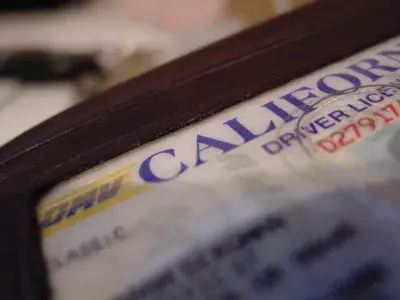
Again, while you may not need a passport, you should want to have one! With the backlog in issuing passports, though, you may find yourself in a situation where it just is not possible to obtain prior to cruise Alaska cruise vacation.
Well, as long as you are certain that your cruise is closed-loop sailing that begins and ends in the same U.S. port, do not worry-- you will still be able to go on your Alaska vacation!
If you are over the age of 16, you will need to bring an official U.S. state-issued birth certificate (this can be either an original, notarized, or certified copy), as well as a valid driver's license or picture I.D issued by the government that contains a photo, name, and date of birth.
If you do not have an appropriate birth certificate, a Consular Report of Birth Abroad issued by DOS or Certificate of Naturalization issued by U.S. Citizenship and Immigration Services will most likely work; however, you will want to check with your specific cruise line. The requirements are clearly stated on their website, but you can also call them or speak with your travel agent if you have any concerns.

Depending on which cruise line you are sailing with, baptismal papers and hospital certificates of birth may not be accepted. Moreover, voter registration cards or Social Security cards are often not considered proof of citizenship.
There will be no exceptions to this rule, so either have a passport or make sure you have both forms of alternate identification present when boarding the ship. Remember that no refunds will be given if you do not provide proper documentation!
Why must Alaska cruises from Seattle stop in a foreign port?

Per the Passenger Vessel Services Act (PVSA), foreign flagged vessels are prohibited from transporting passengers from one United States port to another without first stopping at a distant foreign port.
In the case of Alaska, if you are departing on a roundtrip cruise from Seattle, you will notice that your itinerary includes a stop in Victoria, British Columbia. Since all other ports are in Alaska (i.e., the United States), this is required, so that ships do not violate the PVSA.
Since it is often the last stop of the cruise, if a passenger has to disembark in Alaska for a medical emergency, the cruise line will face a fine of $798 per passenger. If a family of four has to unexpectedly get off the ship in Juneau after departing from Whittier, the total fine will be close to $3,200!
Cruises that begin in Seward or Whittier and end in Vancouver do not have to worry about adding a distant foreign port to appease the PVSA, as they are not transporting guests between two U.S. ports; they are beginning and ending in different countries. If, however, they disembark prior to reaching Canada, that would be considered violating the act, as Seward and, for instance, Icy Straight Point are both in the U.S.
Read more: What Is the Jones Act, and How Does It Differ From the Passenger Vessel Services Act?
Why should you cruise to Alaska?

Alaska is full of beautiful glaciers, snow-capped mountains, and exciting shore excursions. Where else can you go dog sledding or take a helicopter ride above a famous glacier? Taking an Alaskan cruise offer cruisers a truly unique and once-in-a-lifetime vacation experience that other places (i.e., the Caribbean, Bahamas, or Mexico) cannot compete with!
When taking a cruise to Alaska, you will be able to different ports along the coast, and on sea days, you will sail through fjords and marvel in the natural beauty of Alaska from the comfort of your cruise ship.
This vacation will not be your typical cruise, and you should not expect to spend your days lounging by the pool with a cocktail in hand. Be prepared to be adventurous and do things that you have never done before!
Read more: Why you should book an Alaska cruise now
How much does a cruise to Alaska cost?
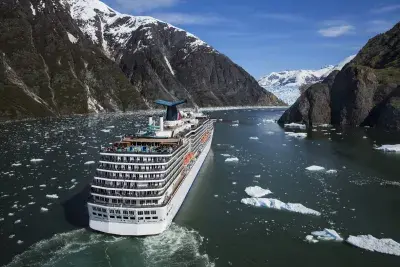
If you have flexibility in your schedule, you may find that the cost of an Alaska cruise is not as expensive as you thought! During the shoulder season, it is not uncommon to find fares as low as $350 per person based on double occupancy for an interior room.
That being said, before booking a cheap cruise fare, you will want to research all extra costs that you may encounter. When cruising to Alaska, you will want to have a generous budget for shore excursions. Due to their intensity level and duration, they can often be pretty expensive! Some can cost over $100 per person.
Additionally, you will have to pay port fees. These are unavoidable and can cost upwards of $200 per person. Rarely do cruise lines include these fees in their advertised rate.
And if you are cruising to Alaska, there is a good chance that you might want a balcony cabin with a private verandah that allows you to sit outside and soak in the beautiful scenery! Well, you are not alone. Balcony cabins are extremely desirable on Alaska cruises, and they are priced at a premium! If an interior cabin costs $350 per person, you might be looking at triple for a balcony.
Read more: What to know before booking a cheap cruise
Cruising to Alaska without a passport
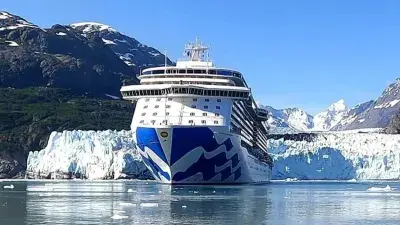
Just to recap, you do not necessarily have to have a passport to cruise to Alaska. As long as you are a United States citizen and the cruise is making a close-loop sailing out of a U.S. port, you can cruise as long as you carry the proper alternate identification.
This includes an official U.S. state-issued birth certificate and valid driver's license or picture other I.D issued by the government that includes a photo, your name, and date of birth.
If your itinerary begins and ends in a different port (even if they are both U.S. ports like Seattle and San Francisco), you will have to have a valid passport. Be sure to check your expiration date as soon as you confirm the dates of the cruise. If it expires within six months of the sailing, you will need to get it renewed beforehand.
Regardless of whether you need one or not, we recommend always cruising with a passport. You never know when there will be an emergency, and getting home will be much easier if you have one.





